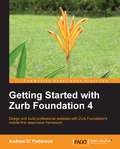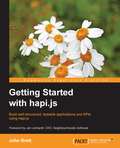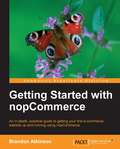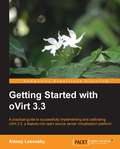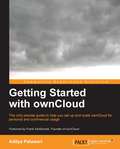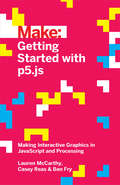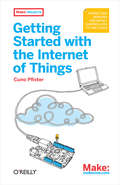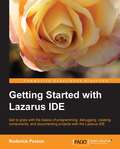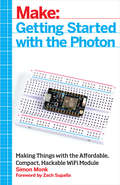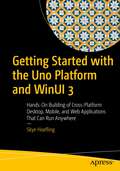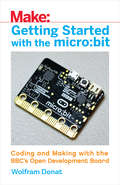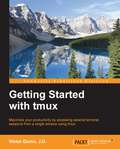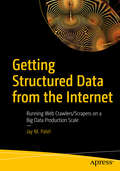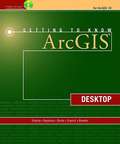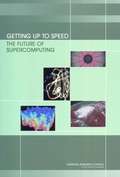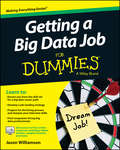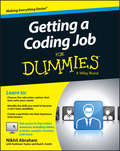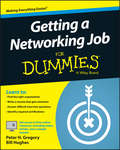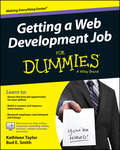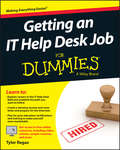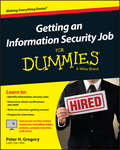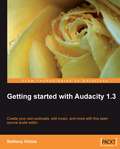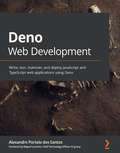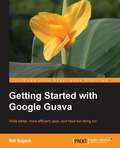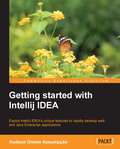- Table View
- List View
Getting Started with Zurb Foundation 4
by Andrew D. PattersonThe book starts with the basics of Foundation and helps you build your skills as you advance from installation to design, configuration, and customization with examples at every step.This book will be of great benefit to web architects, designers, and builders. While it helps to be a programmer, it isn't necessary for this book. You should be familiar with the basic principles of responsive web design and have a desire to create a professional website that looks great on both mobile devices and regular displays.
Getting Started with hapi.js
by John BrettBuild well-structured, testable applications and APIs using hapi.js About This Book * With the help of this book, you will improve your productivity as a developer and that of your team by focusing on business logic utilizing the structure that Hapi.js provides * You will be introduced to a real-world problem and we'll demonstrate how to use the tools Hapi provides to resolve it * This is the only book with a learn-by-example approach Who This Book Is For If you are a JavaScript developer with or without Node.js experience and would like to learn to build applications, APIs, and web servers with the best-in-class framework hapi.js, this book is perfect for you. What You Will Learn * Increase your productivity by taking advantage of the out-of-the-box features hapi.js provides * Build secure API servers * Create websites and applications using your favorite templating language * Leverage hapi.js plugins to better structure your codebase * Simplify your security workflows with the built-in authentication and authorization functionality of hapi.js * Ensure application reliability with testing and code coverage * Reduce code complexity using reusable validation logic with joi * Gather insight into your application performance via logging * Start the journey to building robust production-ready applications In Detail This book will introduce hapi.js and walk you through the creation of your first working application using the out-of-the-box features hapi.js provides. Packed with real-world problems and examples, this book introduces some of the basic concepts of hapi.js and Node.js and takes you through the typical journey you'll face when developing an application. Starting with easier concepts such as routing requests, building APIs serving JSON, using templates to build websites and applications, and connecting databases, we then move on to more complex problems such as authentication, model validation, caching, and techniques for structuring your codebase to scale gracefully. You will also develop skills to ensure your application's reliability through testing, code coverage, and logging. By the end of this book, you'll be equipped with all the skills you need to build your first fully featured application. This book will be invaluable if you are investigating Node.js frameworks or planning on using hapi.js in your next project. Style and approach This book takes a step-by-step approach to building an application or web server using hapi.js though examples.
Getting Started with nopCommerce
by Brandon AtkinsonA friendly, tutorial style book, which will help you learn your way through creating a live storefront with nopCommerce in a step-by-step manner.Getting Started with nopCommerce is for anyone who wants to sell products online using nopCommerce. If you are a non-technical person and are discouraged by the complexity of this powerful e-commerce application, then this book is for you.
Getting Started with oVirt 3.3
by Alexey LesovskyGetting Started with oVirt 3.3 has a tutorial-based approach to learning oVirt KVM virtualization. This book will introduce you to the various components of the oVirt engine and will show you how to implement virtualization.This book is designed for technicians and system administrators who are interested in virtualization technology in Linux / UNIX. It is assumed that you have an understanding of virtualization in general as well as what issues it solves. You will also need a basic knowledge of how to work on the command line in Linux.
Getting Started with ownCloud
by Aditya PatawariThis is a standard, precise, and short tutorial for setting up ownCloud and includes advanced topics like encryption, user management, and server security. This ownCloud book would be an ideal starting point for anyone who wants to store their data and also share it.This book is for first time users as well as administrators who are interested or responsible for managing an ownCloud instance. You do not need any prior experience with any of the technology, including Linux/Windows, Apache/IIS, SQLite/MySQL, or even PHP. It is a beginner-friendly book, written with a first time user in mind.
Getting Started with p5.js: Making Interactive Graphics in JavaScript and Processing
by Ben Fry Casey Reas Lauren McCarthyWith p5.js, you can think of your entire Web browser as your canvas for sketching with code! Learn programming the fun way--by sketching with interactive computer graphics! Getting Started with p5.js contains techniques that can be applied to creating games, animations, and interfaces. p5.js is a new interpretation of Processing written in JavaScript that makes it easy to interact with HTML5 objects, including text, input, video, webcam, and sound. Like its older sibling Processing, p5.js makes coding accessible for artists, designers, educators, and beginners. Written by the lead p5.js developer and the founders of Processing, this book provides an introduction to the creative possibilities of today's Web, using JavaScript and HTML. With Getting Started with p5.js, you'll: Quickly learn programming basics, from variables to objectsUnderstand the fundamentals of computer graphicsCreate interactive graphics with easy-to-follow projectsLearn to apply data visualization techniquesCapture and manipulate webcam audio and video feeds in the browser
Getting Started with the Internet of Things: Connecting Sensors and Microcontrollers to the Cloud
by Cuno PfisterWhat is the Internet of Things? It's billions of embedded computers, sensors, and actuators all connected online. If you have basic programming skills, you can use these powerful little devices to create a variety of useful systems—such as a device that waters plants when the soil becomes dry. This hands-on guide shows you how to start building your own fun and fascinating projects.Learn to program embedded devices using the .NET Micro Framework and the Netduino Plus board. Then connect your devices to the Internet with Pachube, a cloud platform for sharing real-time sensor data. All you need is a Netduino Plus, a USB cable, a couple of sensors, an Ethernet connection to the Internet—and your imagination.Develop programs with simple outputs (actuators) and inputs (sensors)Learn about the Internet of Things and the Web of ThingsBuild client programs that push sensor readings from a device to a web serviceCreate server programs that allow you to control a device over the WebGet the .NET classes and methods needed to implement all of the book's examples
Getting Started with the Lazarus IDE
by Roderick PersonThis book is written in a simple, easy-to-understand format with lots of screenshots and step-by-step explanations.This book is geared toward developers that have a familiarity with Delphi or Free Pascal and would like to start using the open source Lazarus Integrated Development Environment. You should have knowledge of creating a console and GUI applications as well as creating basic components. Example source code and projects are provided to help learn the differences between Delphi and Lazarus projects.
Getting Started with the Photon: Making Things with the Affordable, Compact, Hackable WiFi Module
by Simon MonkThe Photon is an open source, inexpensive, programmable, WiFi-enabled module for building connected projects and prototypes. Powered by an ARM Cortex-M3 microcontroller and a Broadcom WiFi chip, the Photon is just as happy plugged into a hobbyist's breadboard as it is into a product rolling off of an assembly line. While the Photon--and its accompanying cloud platform--is designed as a ready-to-go foundation for product developers and manufacturers, it's great for Maker projects, as you'll see in this book. You'll learn how to get started with the free development tools, deploy your sketches over WiFi, and build electronic projects that take advantage of the Photon's processing power, cloud platform, and input/output pins. What's more, the Photon is backward-compatible with its predecessor, the Spark Core.
Getting Started with the Uno Platform and WinUI 3: Hands-On Building of Cross-Platform Desktop, Mobile, and Web Applications That Can Run Anywhere
by Skye HoeflingGet ready to build applications that can run anywhere using the Uno Platform and WinUI.Modern application development can be an intimidating and complex topic, especially when you are building cross-platform applications that need to support multiple operating systems and form factors. There are so many options when it comes to frameworks and selecting the right one for your enterprise is critical in delivering a successful product to market. For the developer who has zero experience building apps with Xamarin, UWP, WinUI, or the Uno Platform, this book deconstructs those complex concepts into tangible building blocks so that productivity gains are immediately recognized.You will start off learning basic concepts and get a bird's-eye view of the enabling technologies to ensure that you feel comfortable with the tools and terminology. From there, you will learn about some of the more popular options in the .NET ecosystem, understand their attributes and shortcomings, and learn why the Uno Platform is ideal for building a cross-platform application that targets Android, iOS, Windows, WASM (Web Assembly), Linux, and MacOS. Then, you will follow a product release timeline that takes you through building an application, introducing key concepts at every step of the way. Each section of the book is chock full of tips and edge case documentations for the different platforms.What You Will Learn Manage multi-targeting solutions: specifically, how to handle the different project headsEffectively write cross-platform software and handle the edge cases of the different platformsUnderstand the fundamentals of working with Uno Platform WinUI appsExplore enterprise-grade application architecture using MVVMUnderstand Dependency Injection and how it applies to application architecture Who This Book Is ForDevelopers who understand some basics of C# and object-oriented programming
Getting Started with the micro: Coding and Making with the BBC's Open Development Board
by Wolfram DonatThe micro:bit, a tiny computer being distributed by the BBC to students all over the UK, is now available for anyone to purchase and play with. Its small size and low power requirements make it an ideal project platform for hobbyists and makers. You don't have to be limited by the web-based programming solutions, however: the hardware on the board is deceptively powerful, and this book will teach you how to really harness the power of the micro:bit. You'll learn about sensors, Bluetooth communications, and embedded operating systems, and along the way you'll develop an understanding of the next big thing in computers: the Internet of Things.
Getting Started with tmux
by Victor Quinn J.DThe book is intended for software developers, DevOps engineers, and other professionals who make heavy use of the terminal in their daily workflow. Some familiarity with the terminal is useful but no prior experience with tmux or other terminal multiplexers (such as GNU Screen) is required.
Getting Structured Data from the Internet: Running Web Crawlers/Scrapers on a Big Data Production Scale
by Jay M. PatelUtilize web scraping at scale to quickly get unlimited amounts of free data available on the web into a structured format. This book teaches you to use Python scripts to crawl through websites at scale and scrape data from HTML and JavaScript-enabled pages and convert it into structured data formats such as CSV, Excel, JSON, or load it into a SQL database of your choice. This book goes beyond the basics of web scraping and covers advanced topics such as natural language processing (NLP) and text analytics to extract names of people, places, email addresses, contact details, etc., from a page at production scale using distributed big data techniques on an Amazon Web Services (AWS)-based cloud infrastructure. It book covers developing a robust data processing and ingestion pipeline on the Common Crawl corpus, containing petabytes of data publicly available and a web crawl data set available on AWS's registry of open data.Getting Structured Data from the Internet also includes a step-by-step tutorial on deploying your own crawlers using a production web scraping framework (such as Scrapy) and dealing with real-world issues (such as breaking Captcha, proxy IP rotation, and more). Code used in the book is provided to help you understand the concepts in practice and write your own web crawler to power your business ideas. What You Will LearnUnderstand web scraping, its applications/uses, and how to avoid web scraping by hitting publicly available rest API endpoints to directly get dataDevelop a web scraper and crawler from scratch using lxml and BeautifulSoup library, and learn about scraping from JavaScript-enabled pages using SeleniumUse AWS-based cloud computing with EC2, S3, Athena, SQS, and SNS to analyze, extract, and store useful insights from crawled pagesUse SQL language on PostgreSQL running on Amazon Relational Database Service (RDS) and SQLite using SQLalchemyReview sci-kit learn, Gensim, and spaCy to perform NLP tasks on scraped web pages such as name entity recognition, topic clustering (Kmeans, Agglomerative Clustering), topic modeling (LDA, NMF, LSI), topic classification (naive Bayes, Gradient Boosting Classifier) and text similarity (cosine distance-based nearest neighbors)Handle web archival file formats and explore Common Crawl open data on AWSIllustrate practical applications for web crawl data by building a similar website tool and a technology profiler similar to builtwith.comWrite scripts to create a backlinks database on a web scale similar to Ahrefs.com, Moz.com, Majestic.com, etc., for search engine optimization (SEO), competitor research, and determining website domain authority and rankingUse web crawl data to build a news sentiment analysis system or alternative financial analysis covering stock market trading signalsWrite a production-ready crawler in Python using Scrapy framework and deal with practical workarounds for Captchas, IP rotation, and moreWho This Book Is ForPrimary audience: data analysts and scientists with little to no exposure to real-world data processing challenges, secondary: experienced software developers doing web-heavy data processing who need a primer, tertiary: business owners and startup founders who need to know more about implementation to better direct their technical team
Getting To Know ArcGIS Desktop
by Tim Ormsby Eileen J. Napoleon Robert Burke Carolyn Groessl Laura BowdenGetting to Know ArcGIS Desktop introduces principles of GIS as it teaches the mechanics of using ESRI's leading technology. Key concepts are combined with detailed illustrations and step-by-step exercises to acquaint readers with the building blocks of ArcGIS Desktop including ArcMap", for displaying and querying maps, ArcCatalog", for organizing geographic data, and Model Builder", for diagramming and processing solutions to complex spatial analysis problems. Its broad scope, simple style, and practical orientation make this book an ideal classroom text and an excellent resource for those learning GIS on their own. A data CD for working through the exercises and a fully functioning 180-day trial ArcGIS Desktop 10 software is included.
Getting Up To Speed The Future Of Supercomputing
by National Research Council of the National AcademiesSupercomputers play a significant and growing role in a variety of areas important to the nation. They are used to address challenging science and technology problems. In recent years, however, progress in supercomputing in the United States has slowed. The development of the Earth Simulator supercomputer by Japan that the United States could lose its competitive advantage and, more importantly, the national competence needed to achieve national goals. In the wake of this development, the Department of Energy asked the NRC to assess the state of U. S. supercomputing capabilities and relevant R&D. Subsequently, the Senate directed DOE in S. Rpt. 107-220 to ask the NRC to evaluate the Advanced Simulation and Computing program of the National Nuclear Security Administration at DOE in light of the development of the Earth Simulator. This report provides an assessment of the current status of supercomputing in the United States including a review of current demand and technology, infrastructure and institutions, and international activities.
Getting a Big Data Job For Dummies
by Jason WilliamsonHone your analytic talents and become part of the next big thingGetting a Big Data Job For Dummies is the ultimate guide to landing a position in one of the fastest-growing fields in the modern economy. Learn exactly what "big data" means, why it's so important across all industries, and how you can obtain one of the most sought-after skill sets of the decade. This book walks you through the process of identifying your ideal big data job, shaping the perfect resume, and nailing the interview, all in one easy-to-read guide.Companies from all industries, including finance, technology, medicine, and defense, are harnessing massive amounts of data to reap a competitive advantage. The demand for big data professionals is growing every year, and experts forecast an estimated 1.9 million additional U.S. jobs in big data by 2015. Whether your niche is developing the technology, handling the data, or analyzing the results, turning your attention to a career in big data can lead to a more secure, more lucrative career path. Getting a Big Data Job For Dummies provides an overview of the big data career arc, and then shows you how to get your foot in the door with topics like:The education you need to succeedThe range of big data career path optionsAn overview of major big data employersA plan to develop your job-landing strategyYour analytic inclinations may be your ticket to long-lasting success. In a highly competitive job market, developing your data skills can create a situation where you pick your employer rather than the other way around. If you're ready to get in on the ground floor of the next big thing, Getting a Big Data Job For Dummies will teach you everything you need to know to get started today.
Getting a Coding Job For Dummies
by Nikhil AbrahamYour friendly guide to getting a job in coding Getting a Coding Job For Dummies explains how a coder works in (or out of) an organization, the key skills any job requires, the basics of the technologies a coding pro will encounter, and how to find formal or informal ways to build your skills. Plus, it paints a picture of the world a coder lives in, outlines how to build a resume to land a coding job, and so much more. Coding is one of the most in-demand skills in today's job market, yet there seems to be an ongoing deficit of candidates qualified to take these jobs. Getting a Coding Job For Dummies provides a road map for students, post-grads, career switchers, and anyone else interested in starting a career in coding. Inside this friendly guide, you'll find the steps needed to learn the hard and soft skills of coding--and the world of programming at large. Along the way, you'll set a clear career path based on your goals and discover the resources that can best help you build your coding skills to make you a suitable job candidate. Covers the breadth of job opportunities as a coder Includes tips on educational resources for coders and ways to build a positive reputation Shows you how to research potential employers and impress interviewers Offers access to online video, articles, and sample resume templates If you're interested in pursuing a job in coding, but don't know the best way to get there, Getting a Coding Job For Dummies is your compass!
Getting a Networking Job For Dummies
by Peter H. Gregory Bill HughesEverything you need to start your career in computer networking Looking to land that computer networking position? Look no further! Getting a Networking Job For Dummies offers all the tools and step-by-step guidance you need to stand out from the crowd, get your foot in the door, and secure a job in this fast-growing sector. In no time, you'll get a handle on networking roles, necessary education, training, and certifications, ways to brand yourself for your dream career, and so much more. These days, computer networking can be a complicated industry, and knowing what you need to do to make yourself an attractive candidate for a coveted networking position can make all the difference. Luckily, Getting a Networking Job For Dummies arms you with everything you need to be one step ahead of the game. Humorous, practical, and packed with authoritative information, this down-to-earth guide is your go-to handbook for scoring that sought-after computer networking position! Find the right organization for you Write a winning resume that gets attention Answer difficult interview questions with confidence Identify required certifications to get the job you want If you're a prospective computer networking employee looking to present yourself as a strong, competitive candidate in the computer networking market, this hands-on guide sets you up for success.
Getting a Web Development Job For Dummies
by Bud E. Smith Kathleen TaylorCraving a career in web dev? Chart your path with this helpful guideGetting a Web Development Job For Dummies provides a roadmap to one of the "hot jobs" in the booming world of tech. The web development field is large, and it encompasses many actual functions. This book helps you understand the web development career opportunities and determine the path you should take, based on your own personal needs and preferences, to launch your career. You'll learn about various career options, the skills you'll need to become an attractive candidate, how to go about learning the ropes, and proving your abilities to a potential employer or client. With so many possible goals and no one right way to get there, this book cuts through the confusion to put you on the path to a career you want.The web development industry is expected to grow for the foreseeable future, and there is already a shortage of trained workers to fill the jobs. Whether you lean technical or aesthetic, you can find your place in the industry with right skills--both hard and soft--and with the right plan. Getting a Web Development Job For Dummies is your guide to formulating that plan and getting started right.Find formal or informal ways to build the tech skills you'll needDiscover where you fit, whether as a freelancer or within an organizationLearn how to build a resume, develop a portfolio, and impress interviewersGet expert tips on finding resources, building a reputation, and moreIf your pet peeves include malfunctioning forms, flashing banners, and sites that take way too long to load, the web development world needs you. But before you begin your journey, you need a destination and a route in mind. Getting a Web Development Job For Dummies is your roadmap, so you can set out today.
Getting an IT Help Desk Job For Dummies
by Tyler RegasStand out in one of IT's fastest growing job markets If you're looking for a job in IT, the help desk is the heart and soul of most IT operations, and an excellent starting point for a promising career. With the help of Getting an IT Help Desk Job For Dummies, you'll gain the knowledge and know-how to cut through the confusion of navigating the Information Technology job market. IT can be intimidating to hopeful-yet-inexperienced job candidates, but this guide will help you find and land the job of your dreams. Through easy-to-follow explanations, authoritative information, and a bit of humor, Getting an IT Help Desk Job For Dummies serves as your thorough and approachable guide to maximizing your competitive edge in this booming market. The IT job market has continued to expand as technology matures and deepens its roots in business operations. This is good news for you! However, it makes it that much harder to get a job in IT, as recent grads and other professionals are practically stampeding to get their feet in the door of this rapidly expanding industry. Luckily, Getting an IT Help Desk Job For Dummies gives you an advantage by providing expert instruction on how to score an interview and secure a job offer, the skills needed to obtain and maintain an IT position, and authoritative information on how to establish a career path in the IT field. Explore careers in the IT Help Desk field and establish the path you want to follow Plan for post-education certifications and training to make yourself more marketable Get expert guidance for creating a winning resume and cover letter Prepare for your IT Help Desk interview Loaded with simple, straight-forward advice, Getting an IT Help Desk Job For Dummies is your all-in-one guide to starting your IT career on the right foot!
Getting an Information Security Job For Dummies
by Peter H. GregoryGet prepared for your Information Security job search! Do you want to equip yourself with the knowledge necessary to succeed in the Information Security job market? If so, you've come to the right place. Packed with the latest and most effective strategies for landing a lucrative job in this popular and quickly-growing field, Getting an Information Security Job For Dummies provides no-nonsense guidance on everything you need to get ahead of the competition and launch yourself into your dream job as an Information Security (IS) guru. Inside, you'll discover the fascinating history, projected future, and current applications/issues in the IS field. Next, you'll get up to speed on the general educational concepts you'll be exposed to while earning your analyst certification and the technical requirements for obtaining an IS position. Finally, learn how to set yourself up for job hunting success with trusted and supportive guidance on creating a winning resume, gaining attention with your cover letter, following up after an initial interview, and much more. Covers the certifications needed for various jobs in the Information Security field Offers guidance on writing an attention-getting resume Provides access to helpful videos, along with other online bonus materials Offers advice on branding yourself and securing your future in Information Security If you're a student, recent graduate, or professional looking to break into the field of Information Security, this hands-on, friendly guide has you covered.
Getting started with Audacity 1.3
by Bethany HiitolaConversational and practical, this book is full of real life examples of where and how you would use the Audacity software. Not only does it give you task-based step-by-step instructions from installation to advanced audio editing techniques, it caters to the beginner to familiarize them with all the jargon, suggests recording equipment, it walks them through a simple sample project showing off everything Audacity can do. If you are new to audio recording and editing, and particularly using the Audacity software, this book is for you. It explains everything from common audio industry terms and software basics. Technical sound engineering details and jargon are omitted to keep the book friendly and easy to understand.
Getting started with Deno
by Alexandre SantosServer-side web development with Deno made easyKey FeaturesGet to grips with the essential concepts and techniques relating to DenoLearn how to use Deno in real-world scenariosDevelop, test and deploy web applications and tools using DenoBook DescriptionDeno is a modern and secure JavaScript and TypeScript runtime that evolved from Node.js. It leverages the features of modern JavaScript, adding a secure by default layer and shipping the complete toolset in the runtime binary.Getting Started with Deno will introduce Deno’s primitives and explain how you can use them to build real-world applications. The book starts by explaining the importance of Deno. You’ll explore Node.js, understanding its benefits and why its release took the world by storm. The chapters then go on to explain the purpose Deno serves in today’s world, including the need for security models and decentralized dependency management, neither of which exist in Node. Later, you’ll gain insights into Deno’s ecosystem and toolchain. In addition to this, you’ll get up to speed with writing simple CLI applications, while also exploring Deno APIs and standard modules. Toward the concluding chapters, you’ll be guided through the process of building a complete API with Deno.By the end of this Deno book, you’ll have learned how to use Deno to create and maintain secure and reliable applications.What you will learnUnderstand why you should use DenoGet to grips with tooling and the Deno ecosystemLeverage the standard library and Deno’s security modelExplore common practices and web frameworks to build a REST API in DenoImplement real-world functionalities in Deno through a step-by-step processUse dependency injection and inversion of control (IoC), along with exploring application architecture practicesTest and deploy a Deno application in isolation using DockerWho This Book Is ForThis book is for developers who want to leverage their JavaScript and TypeScript skills in a secure, simple, and modern runtime, using them for web application development. Although prior knowledge of Node.js is not necessary, it is recommended to easily get started with learning web development with Deno.Table of ContentsWhat is DenoThe toolchainRuntime and standard-libraryBuilding your first web applicationAdding Users and Migrating to OakAdding Authentication and Connecting to the DatabaseHTTPS, extracting configuration, and Deno oin the browserTesting - Unit and Integration Deploying a Deno applicationWrapping up
Getting started with Google Guava
by Bill BejeckThis is a short, practical guide, with lots of examples to help you learn Google Guava.There is no minimum level of experience required. There is something for everyone who works with Java, from the beginner to the expert programmer.
Getting started with IntelliJ IDEA
by Hudson Orsine AssumpcaoA practical, fast-paced guide with clear, step-by-step exercisesto help you understand the basics of IntelliJ Idea and develop a web application.This book will be ideal if you are a Java developer who has a little knowledge about IntelliJ and wants to get more information on using it to improve your development performance.
